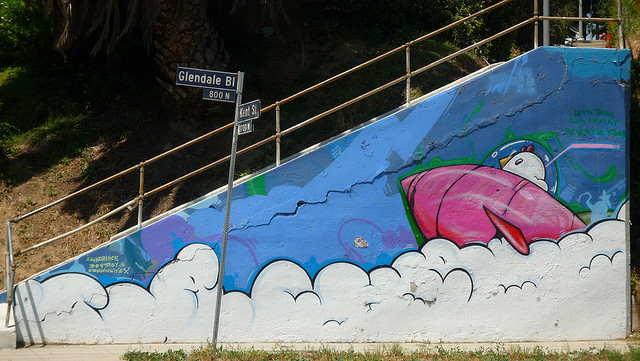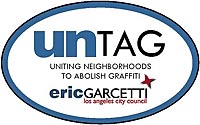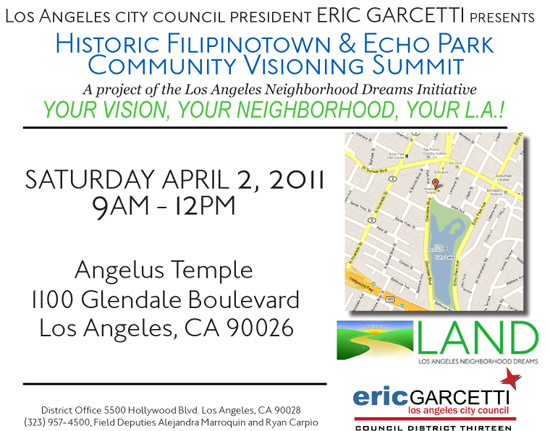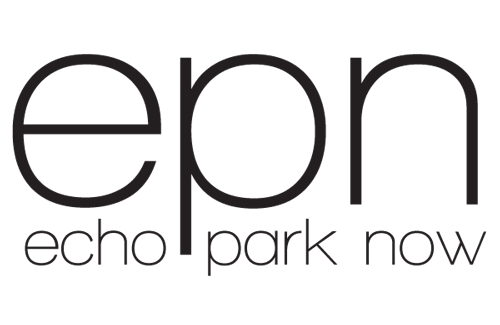
We choose not to glorify gang graffiti, so here's the kind of artwork we prefer. Flickr photo via KellyLA.
Once upon a time, there was little to no city-funded programs to help clean up graffiti in Echo Park. Residents and activists involved in the Echo Park Improvement Association (EPIA) would drive around with paint in the trunk of their cars to paint over any new graffiti on the spot. Other residents could join a $10 per month program that would help Central City Action Committee (CCAC) pay for graffiti removal on the weekends.
It’s been a while since those days, but a recent proposal from the Mayor’s office to cut funding to graffiti abatement program has a few people worried. How will crime, safety, and the quality of life be affected if the streets are covered in graffiti?
According to an LA Times article, the budget cut would save the city $1.5 million per year (out of a total of $7 million spent on eradicating graffiti city-wide). For Echo Park and the CCAC (which is one of 14 contractors in the city with the same directive), the cut would actually reduce our anti-graffiti forces by 50%. Right now the non-profit has six teams out there for around 20 Los Angeles neighborhoods from Highland Park to Venice. A 50% reduction would be drastic.
Opposition to the budget cut isn’t without reason – everyone is fully aware of the budget issues on our communities and our city. It’s about prioritizing, as we all know, and for most of us our safety and the overall quality of life is affected by graffiti. When those gang names are crossed out and written over by a competing group, it’s concerning. And if it stays up, the crime could worsen. It’s not a risk we’re willing to take.
“What happens once the graffiti starts going up,” said CCAC director MaryAnne Hayashi, “you would never catch up…. I really think it’s a quality of life issue. People really deserve to have a clean neighborhood.”
The good news is, the everyone seems to be rallying against the graffiti budget cuts, even Eric Garcetti of CD 13. Spokesperson Yusef Robb told us, to our relief, that Garcetti’s office was fighting the graffiti cutbacks. “When it comes to graffiti,” he said, “the return that we get in terms of quality of life as well as financially makes it a worthy investment.
And what an investment – CCAC removed 3.5 million square feet of graffiti in CD1 and one million from CD13.
 Over the past five or six years, Garcetti’s anti-graffiti program UNTAG (Uniting Neighborhoods to Abolish Graffiti) has seen a 70% decrease in graffiti district-wide. The program recruits block captains to oversee and organize neighborhoods to report graffiti for city crews to then clean up. If the city cuts the anti-graffiti budget, the simple fact is there will be less money for painting over graffiti and revitalizing neighborhoods.
Over the past five or six years, Garcetti’s anti-graffiti program UNTAG (Uniting Neighborhoods to Abolish Graffiti) has seen a 70% decrease in graffiti district-wide. The program recruits block captains to oversee and organize neighborhoods to report graffiti for city crews to then clean up. If the city cuts the anti-graffiti budget, the simple fact is there will be less money for painting over graffiti and revitalizing neighborhoods.
The best part about non-profits like the CCAC is that they don’t just paint a white block over the graffiti, they make it look good and maintain the beauty of the neighborhood. They also follow certain safety procedures for when they might feel threatened by removing gang graffiti.
While the programs may indeed see some cuts, we’re hoping far less that what’s being proposed. And hopefully we won’t have to drive around with paint in the trunk of the car.
You can help by writing to your Council District representative along with making sure graffiti is reported as soon as you see it. If you see graffiti, call 311, visit the anti-graffiti website at http://anti-graffiti.lacity.org, or use a 311 ap if you have an iPhone or Android phone.
If you’re available during the day to help support the graffiti abatement work, there’s a City Council meeting on the subject on Wednesday, January 12 at 10:00 am.



 Over the past five or six years, Garcetti’s anti-graffiti program
Over the past five or six years, Garcetti’s anti-graffiti program